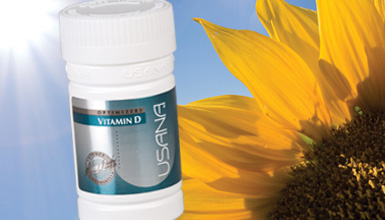Form of Vitamin D
The way vitamin D is made, stored, and utilized in our bodies is unique. That dreaded but marvelous substance, cholesterol, forms the base of a derivative that resides in the fat cells just under the skin. When skin is exposed to ultraviolet (UV) rays from the sun, this derivative is transformed to D3. Diet-derived D2 and D3 each undergo changes in the liver and the kidneys to form both a non-active storage form of the vitamin and the active form (1,25-dihydroxy-vitamin D). In many tissues of our bodies, there are receptors for both forms.
The active form of vitamin D is a steroid, which puts it in a class with other steroids, such as hormones. Since we can get our vitamin D from sources other than diet, some say it is not a vitamin. But if the sun doesn’t shine or we avoid sun exposure by clothing, occupation, or sun block lotions, we must have a dietary source. In latitudes north of San Francisco or south of Buenos Aires, Argentina, UV radiation is very feeble for at least six months of the year. Natural food sources, except for the fish liver oils, are relatively meager.
We are left with the commercial D3 and D2 forms that don’t seem all that attractive when we learn how they are made. Animal skins are treated with organic solvents that extract the cholesterol derivative (7-dehydrocholesterol, the same precursor that resides under our skin), which is then exposed to UV radiation to form D3. D2, said to be derived from plant or “food” sources, occurs naturally in some yeasts and fish, but most of it is obtained from UV radiation of cholesterol derivatives in foods like milk,. Cholesterol extracted from the lanolin of sheep wool, after going through many chemical processes and UV radiation, can generate D2. D3 has greater activity than D2, but both are still in use. The large-dose vitamin D in use now, as a readily available supplement, is the D3 form.
Uses of Vitamin D
The most well known use of the active form of vitamin D, 1,25 D, is its role in bone metabolism. Our bones are a reservoir for calcium, which has many more essential functions than just bone metabolism. If calcium intake is inadequate, or if absorption is poor, the calcium blood level will fall. If the fall is too severe, terrible consequences ensue (tetany, death). Help comes in the form of a hormone released from the parathyroid glands that activates 1,25 D. This reaction quickly relieves the low blood calcium problem, but the calcium is taken from the bone reservoir. The parathyroid hormone also allows enhanced absorption of calcium from the gut, in conjunction with vitamin D. While it causes bone breakdown, it also stimulates the production of bone cells (osteoblasts) to provide new bone growth. This entire metabolic loop is designed as a stop-gap measure and cannot be kept in place for the long term, because the parathyroid glands will continually put out too much hormone and bones will deteriorate. The loop makes it hard to achieve toxic levels, since reserve components of the vitamin are activated only as needed.
Fortunately, long before the mechanism of vitamin D metabolism was understood, doctors and nutrition scientists gave sound prevention-oriented advice. Consequently, we didn’t see rickets. It seems that a long period of complacency followed, without reminders of the grave consequences of vitamin D deficiency. Neither did we have an understanding of vitamin D receptors in the any tissues other than bone. Vitamin D, attached to these receptors, regulates genes responsible for the health of the target organ. Some infants with rickets have heart failure that can be successfully treated and should have been prevented with vitamin D. Besides heart muscle, deficiency affects skeletal muscle and the immune system. Antioxidant production involved in quelling free radical production seems to parallel vitamin D production from the skin. For the last few years it seems a new sue for this “cure-all” vitamin turns up every week. Are these finds new or have they just been ignored for decades?
USANA‘s Vitamin D supplement is made with cholecalciferol (vitamin D3), which research suggests is better than competing forms at raising levels of vitamin D in the blood. The most important forms are vitamin D2 and vitamin D3. The latter is the form normally found in humans and is also the form used in USANA’s Vitamin D supplement.



